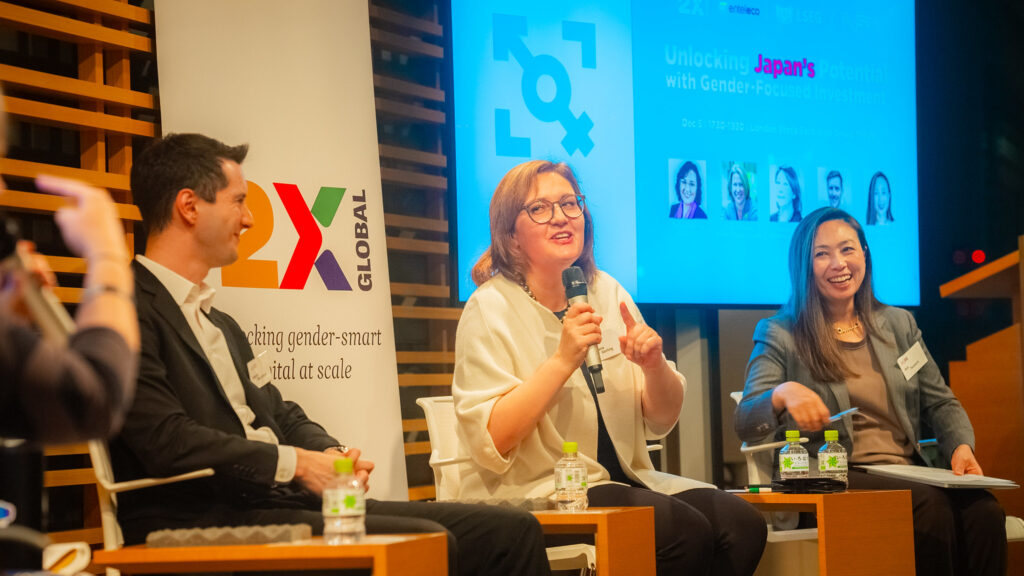Member? Please login
ESG Investing in Japan: Fad or Fact?

Written by Sam Maddicott
October 20, 2017
Past Event Round Ups
Sustainability has become a global investment phenomenon, with the equivalent of 2.6 trillion yen currently invested worldwide in responsible investments. With Japan’s Government Pension Investment Fund (GPIF) taking the lead locally, can Japan’s investment and corporate community lift its game?
That was the key question posed at the October 4th BCCJ event, “Investor stewardship and ESG – where does the true value lie,” co-hosted with the American Chamber of Commerce in Japan’s Alternative Investment Management sub-Committee, in Tokyo.
The panel discussion was moderated by Heather McLeish, senior manager in EY Japan’s Climate Change and Sustainability Services practice, with panellists Arisa Kishigami, head of ESG, Asia Pacific for FTSE Russell, and Emi Onozuka, head of Goldman Sachs Asset Management’s Stewardship Responsibility Group.
Ms McLeish told the audience she had just returned from a trip to Germany where she met representatives of the Principles for Responsible Investment (PRI), a leading proponent of responsible investment. PRI boasts more than 1,750 signatories to its responsible investment principles from more than 50 countries, representing around £53 trillion in assets.
“Do [the global investment managers] all want to save the world? Some of them do. Some just want lower volatility, better performance or better risk management. But all of them understand that sustainable returns, paying attention to your environmental and social impact and having a strong governance culture are all part and parcel of generating strong returns,” she said.
Noting the United Nations’ Sustainable Development Goals, Ms McLeish said regulators, citizens, companies and investors were gradually embracing sustainable development, including investment managers seeking “alpha.”
Sea change
FTSE Russell’s Ms Kishigami works closely with institutional investors and other clients in Japan to support their decision-making, including providing environmental, social and governance (ESG) indices and ratings solutions.
She pointed to the introduction of Japan’s Stewardship Code and the involvement of public pension funds in active ownership and ESG as a sea change for Japan. This included the selection of three ESG indices by the GPIF, including the FTSE Blossom Japan Index, collectively accounting for around 1 trillion Japanese yen in Japanese equities.
While the pressure on Japanese companies to address ESG issues came mainly from foreign influences in the past, she said the GPIF’s leadership had sparked interest in the domestic market from companies, business groups, the Tokyo Stock Exchange and others.
The “GPIF’s intention was to enhance the practices of the market as a whole by showcasing those companies with better ESG practices,” she said. “Driven by an asset owner investing against indices with an explicit selection process, companies have been proactively engaging with us on the international ESG criteria.”

Right focus
However, companies were urged to put their focus into the right areas.
GSAM Japan’s Ms Onozuka explained a US study by Harvard Business School showing that companies with a “proper focus” on material issues and those deemed important by investors outperformed their peers by 6%, but those that put resources into “non-material” factors underperformed by 2%.
“ESG for companies is not about doing everything right, and putting resources everywhere, but selecting the right areas in which to focus their resources and energy on,” she said.
With numerous methods for evaluating ESG, Ms Onozuka said GSAM utilised a range of assessments along with financial analysis to make its investment decisions, since ESG scores do not always tell the whole story.
“There was one case where we really liked a company with a great growth story, with a significant footprint in Southeast Asia, but its ESG score was low relative to its peers so we decided to engage with the company,” she said. “When we talked to the company’s management, they were appreciative of our approach and explained the situation, which was a lot less of a concern than the ESG score implied. Following our discussion, the company contacted the research firm that published the score and learned that it was its disclosure rather than issues with the business itself that had impacted the evaluation.”
Ms Kishigami agreed with Ms Onozuka that materiality is important. She said companies were starting to use the 14 themes and associated 300 indicators underlying the FTSE Blossom Japan Index’s selection to help build a management strategy around improving ESG.
Growth opportunity
ESG can be an opportunity as well as a risk, the panellists said.
“Michael Porter from Harvard Business School has written about creating shared value: a step beyond corporate social responsibility. If you’re going to do good in the world, you can make money from it too, such as by opening up new markets and thinking differently about your product,” Ms McLeish said.
An example of this is microfinance initiatives that allow companies to access new markets in African nations, she added.
Looking ahead, the panellists said ESG should become of greater importance in Japan over the next five to 10 years, providing it was sustained instead of being a “one-off” boom.
“Investors as well as asset owners need to give companies time,” Ms Onozuka said. “The Stewardship Code and Corporate Governance Code hit Japanese companies so quickly; they feel changes need to be made overnight but it’s more about evolution. We need to give them time to succeed, to experiment and to explain.”
Ms McLeish agreed, pointing out that it would take time because of a lack of pressure from civil society demanding change.
“We need to have a fundamental change from both top-down and bottom-up. Boards [in Japan] are not my problem; millennials are not my problem; it’s the middle managers who really don’t understand ESG and don’t want to deal with it until they retire,” she said.
“I’d like to see more engagement with the Mrs Watanabes of the world here—if she starts demanding more change, we could push things faster, but fundamental changes do take time.”







